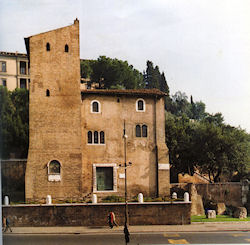Muñoz (1932a, 42) characterises Piazza Montanara as picturesque. He adds that the site was interesting not because of its artistic value,
ma dalla vita dei suoi frequentatori abituali; venditori ambulanti e ciarlatani, vi facevano affari tra loro i campagnoli, i cosiddetti burini che vi si davan convegno ogni mattina, in attesa di essere ingaggiati come sterratori, o vi arrivavano la domenica per le loro compere nei rustici fondaci di attrezzi agricoli, di scarponi e di mantelli. Già da qualche anno il pittoresco quadro andava perdendo la sua vivacità: basti dire che la celebre osteria frequentata dal Goethe, che era proprio in una casa addossata al Teatro di Marcello, era diventata una latteria (Muñoz 1932a, 42)
Perhaps feeling justified by the latter observation, Muñoz had the piazza demolished (Figure 13) and in the process the north-eastern side of the Forum Holitorium, which had been been encased in later constructions, was brought to light. In 1932, the floor of the Forum was exposed during the construction of new sewers (Muñoz 1932a, 44).
These remains can now be seen on either side of the Casina dei Pierleoni, between the Via del Teatro di Marcello and the Vicus Jugarius. A porticoed structure (Figure 14) datable to the 1st-2nd century CE was found to the north and to the south of the Casina, connected to the porticus of Via della Bufala, which was built in volcanic rock (peperino) and dated to the 1st century CE. This was recently identified as the porticus triumphi (Muñoz 1932a, 44; Filippi 1999, 87-90; Coarelli 1999b, 151).
Unlike most other medieval structures, the so-called Casina dei Pierleoni was spared because of its 'eleganti trifore e finestrelle arcuate' (elegant trefoil and arched windows) (Muñoz 1932a, 47). It was a house flanked by a tower on Via della Bufala, with unusual masonry of the 12th-13th century. It was heavily restored and the whole side facing Via del Mare was rebuilt, arbitrarily recycling the windows of an adjacent demolished medieval house (the rationale for this work is in Muñoz 1932a, 47). The walls were extensively redone and the tower was buttressed (Figure 15; Krautheimer 1981, 375, fig. 241, calls the conservation work 'barbarous'; see also Motta 1999, 153-6).

Figure 15: The so-called Casina dei Pierleoni before the conservation work of 1998 (from Funari 1999).
© Internet Archaeology/Author(s)
University of York legal statements | Terms and Conditions
| File last updated: Mon Mar 12 2012